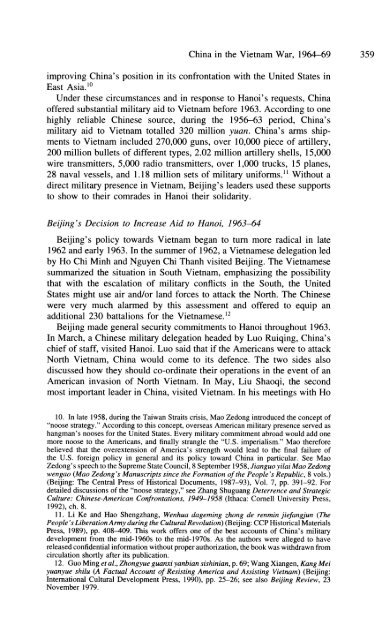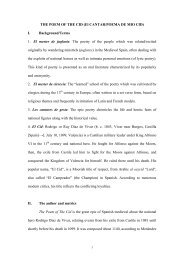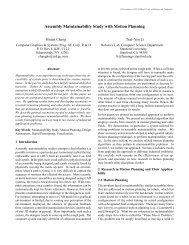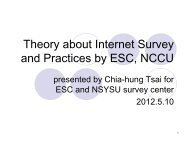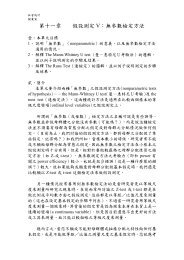358 The Ch<strong>in</strong>a Quarterly1956.6 In <strong>the</strong> summer of 1958 <strong>the</strong> <strong>Vietnam</strong>ese Politburo formally askedBeij<strong>in</strong>g's advice about <strong>the</strong> strategies of <strong>the</strong> "Sou<strong>the</strong>rn revolution." In awritten response, <strong>the</strong> Beij<strong>in</strong>g leadership emphasized that "<strong>the</strong> most fundamental,most important and most urgent task" fac<strong>in</strong>g <strong>the</strong> <strong>Vietnam</strong>eserevolution was "how to promote socialist revolution and reconstruction <strong>in</strong><strong>the</strong> North." "The realization of revolutionary transformation <strong>in</strong> <strong>the</strong>South," accord<strong>in</strong>g to Beij<strong>in</strong>g, "was impossible at <strong>the</strong> current stage."Beij<strong>in</strong>g <strong>the</strong>refore suggested that Hanoi should adopt <strong>in</strong> <strong>the</strong> South astrategy of "not expos<strong>in</strong>g our own forces for a long period, accumulat<strong>in</strong>gour own strength, establish<strong>in</strong>g connections with <strong>the</strong> masses, and wait<strong>in</strong>gfor <strong>the</strong> com<strong>in</strong>g of proper opportunities."' The nation-wide fam<strong>in</strong>e follow<strong>in</strong>g<strong>the</strong> failure of <strong>the</strong> Great Leap Forward forced <strong>the</strong> Beij<strong>in</strong>g leadership tofocus on deal<strong>in</strong>g with domestic issues. Dur<strong>in</strong>g Zhou Enlai's meet<strong>in</strong>gswith Ho Chi M<strong>in</strong>h and Pham Van Dong, North <strong>Vietnam</strong>'s Prime M<strong>in</strong>ister,<strong>in</strong> Hanoi <strong>in</strong> May 1960, he advised <strong>the</strong> <strong>Vietnam</strong>ese that <strong>the</strong>y shouldadopt a flexible approach <strong>in</strong> <strong>the</strong> South by comb<strong>in</strong><strong>in</strong>g political and militarystruggles. He emphasized that even when military struggle seemed <strong>in</strong>evitable,it was still necessary for political struggle to take an importantposition.8 All this <strong>in</strong>dicates that Beij<strong>in</strong>g's leaders were not enthusiasticabout <strong>the</strong>ir <strong>Vietnam</strong>ese comrades start<strong>in</strong>g military struggles <strong>in</strong> <strong>the</strong> South<strong>in</strong> 1959-60, and that "to resume <strong>the</strong> resistance" <strong>in</strong> <strong>the</strong> South was basicallyan <strong>in</strong>itiative by <strong>the</strong> <strong>Vietnam</strong>ese <strong>the</strong>mselves.However, Beij<strong>in</strong>g took no active steps to oppose a revolution <strong>in</strong> South<strong>Vietnam</strong>. The relationship between Communist Ch<strong>in</strong>a and <strong>Vietnam</strong> wasvery close <strong>in</strong> <strong>the</strong> late 1950s and early 1960s.9 The close connection withHanoi, as well as Beij<strong>in</strong>g's revolutionary ideology, would not allow <strong>the</strong>Ch<strong>in</strong>ese to go so far as to become an obstacle to <strong>the</strong> <strong>Vietnam</strong>ese causeof revolution and reunification. The late 1950s and early 1960s also witnessed<strong>in</strong> Ch<strong>in</strong>a <strong>the</strong> cont<strong>in</strong>uous propaganda that Beij<strong>in</strong>g was a natural allyof <strong>the</strong> oppressed peoples of <strong>the</strong> world <strong>in</strong> <strong>the</strong>ir struggles for national liberation.It would be <strong>in</strong>conceivable, <strong>in</strong> such a circumstance, for Beij<strong>in</strong>g toplay too negative a role toward <strong>the</strong> <strong>Vietnam</strong>ese revolution. Fur<strong>the</strong>r, froma strategic po<strong>in</strong>t of view, as S<strong>in</strong>o-American relations experienced severalcrises dur<strong>in</strong>g this period, especially <strong>in</strong> <strong>the</strong> Taiwan Straits <strong>in</strong> 1958, <strong>the</strong>Ch<strong>in</strong>ese leaders would not ignore <strong>the</strong> fact that <strong>in</strong>tensify<strong>in</strong>g revolutionary<strong>in</strong>surgence <strong>in</strong> South <strong>Vietnam</strong> could extend America's commitment, thus6. The Editorial Group for <strong>the</strong> History of Ch<strong>in</strong>ese Military Advisers <strong>in</strong> <strong>Vietnam</strong> (ed.),Zhongguo junshi guwentuan yuanyue kangfa douzheng shishi (A Factual Account of <strong>the</strong>Participation of Ch<strong>in</strong>ese Military Advisory Group <strong>in</strong> <strong>the</strong> Struggle of Assist<strong>in</strong>g <strong>Vietnam</strong> andResist<strong>in</strong>g France) (Beij<strong>in</strong>g: People's Liberation Army Press, 1990), pp. 142-43.7. Guo M<strong>in</strong>g et al., Zhongyue guanxi yanbian sish<strong>in</strong>ian, p. 66; for a <strong>Vietnam</strong>ese versionof <strong>the</strong> story, see The Truth about <strong>Vietnam</strong>o-Ch<strong>in</strong>ese Relations over <strong>the</strong> Past Thirty Years(Hanoi: M<strong>in</strong>istry of Foreign Affairs, 1979), pp. 29-33.8. Guo M<strong>in</strong>g et al., Zhongyue guanxi yanbian sish<strong>in</strong>ian, p. 67; and <strong>the</strong> Institute ofDiplomatic History under Ch<strong>in</strong>ese Foreign M<strong>in</strong>istry (eds.), Zhou Enlai waijiao huodongdashiji, 1949-1975 (A Chronicle of Zhou Enlai's Important Diplomatic Activities) (Beij<strong>in</strong>g:World Affairs Press, 1993), pp. 279-280.9. See Huang Zheng, Hu Zhim<strong>in</strong>g yu Zhongguo (Ho Chi M<strong>in</strong>h and Ch<strong>in</strong>a) (Beij<strong>in</strong>g:People's Liberation Army Press, 1987), ch. 6.
Ch<strong>in</strong>a <strong>in</strong> <strong>the</strong> <strong>Vietnam</strong> <strong>War</strong>, <strong>1964</strong>-69 359improv<strong>in</strong>g <strong>Ch<strong>in</strong>a's</strong> position <strong>in</strong> its confrontation with <strong>the</strong> United States <strong>in</strong>East Asia.'"Under <strong>the</strong>se circumstances and <strong>in</strong> response to Hanoi's requests, Ch<strong>in</strong>aoffered substantial military aid to <strong>Vietnam</strong> before 1963. Accord<strong>in</strong>g to onehighly reliable Ch<strong>in</strong>ese source, dur<strong>in</strong>g <strong>the</strong> 1956-63 period, <strong>Ch<strong>in</strong>a's</strong>military aid to <strong>Vietnam</strong> totalled 320 million yuan. <strong>Ch<strong>in</strong>a's</strong> arms shipmentsto <strong>Vietnam</strong> <strong>in</strong>cluded 270,000 guns, over 10,000 piece of artillery,200 million bullets of different types, 2.02 million artillery shells, 15,000wire transmitters, 5,000 radio transmitters, over 1,000 trucks, 15 planes,28 naval vessels, and 1.18 million sets of military uniforms." Without adirect military presence <strong>in</strong> <strong>Vietnam</strong>, Beij<strong>in</strong>g's leaders used <strong>the</strong>se supportsto show to <strong>the</strong>ir comrades <strong>in</strong> Hanoi <strong>the</strong>ir solidarity.Beij<strong>in</strong>g's Decision to Increase Aid to Hanoi, 1963-64Beij<strong>in</strong>g's policy towards <strong>Vietnam</strong> began to turn more radical <strong>in</strong> late1962 and early 1963. In <strong>the</strong> summer of 1962, a <strong>Vietnam</strong>ese delegation ledby Ho Chi M<strong>in</strong>h and Nguyen Chi Thanh visited Beij<strong>in</strong>g. The <strong>Vietnam</strong>esesummarized <strong>the</strong> situation <strong>in</strong> South <strong>Vietnam</strong>, emphasiz<strong>in</strong>g <strong>the</strong> possibilitythat with <strong>the</strong> escalation of military conflicts <strong>in</strong> <strong>the</strong> South, <strong>the</strong> UnitedStates might use air and/or land forces to attack <strong>the</strong> North. The Ch<strong>in</strong>esewere very much alarmed by this assessment and offered to equip anadditional 230 battalions for <strong>the</strong> <strong>Vietnam</strong>ese.'2Beij<strong>in</strong>g made general security commitments to Hanoi throughout 1963.In March, a Ch<strong>in</strong>ese military delegation headed by Luo Ruiq<strong>in</strong>g, <strong>Ch<strong>in</strong>a's</strong>chief of staff, visited Hanoi. Luo said that if <strong>the</strong> Americans were to attackNorth <strong>Vietnam</strong>, Ch<strong>in</strong>a would come to its defence. The two sides alsodiscussed how <strong>the</strong>y should co-ord<strong>in</strong>ate <strong>the</strong>ir operations <strong>in</strong> <strong>the</strong> event of anAmerican <strong>in</strong>vasion of North <strong>Vietnam</strong>. In May, Liu Shaoqi, <strong>the</strong> secondmost important leader <strong>in</strong> Ch<strong>in</strong>a, visited <strong>Vietnam</strong>. In his meet<strong>in</strong>gs with Ho10. In late 1958, dur<strong>in</strong>g <strong>the</strong> Taiwan Straits crisis, Mao Zedong <strong>in</strong>troduced <strong>the</strong> concept of"noose strategy." Accord<strong>in</strong>g to this concept, overseas American military presence served ashangman's nooses for <strong>the</strong> United States. Every military commitment abroad would add onemore noose to <strong>the</strong> Americans, and f<strong>in</strong>ally strangle <strong>the</strong> "U.S. imperialism." Mao <strong>the</strong>reforebelieved that <strong>the</strong> overextension of America's strength would lead to <strong>the</strong> f<strong>in</strong>al failure of<strong>the</strong> U.S. foreign policy <strong>in</strong> general and its policy toward Ch<strong>in</strong>a <strong>in</strong> particular. See MaoZedong's speech to <strong>the</strong> Supreme State Council, 8 September 1958, <strong>Jian</strong>guo yilai Mao Zedongwengao (Mao Zedong's Manuscripts s<strong>in</strong>ce <strong>the</strong> Formation of <strong>the</strong> People's Republic, 8 vols.)(Beij<strong>in</strong>g: The Central Press of Historical Documents, 1987-93), Vol. 7, pp. 391-92. Fordetailed discussions of <strong>the</strong> "noose strategy," see Zhang Shuguang Deterrence and StrategicCulture: Ch<strong>in</strong>ese-American Confrontations, 1949-1958 (Ithaca: Cornell University Press,1992), ch. 8.11. Li Ke and Hao Shengzhang, Wenhua dagem<strong>in</strong>g zhong de renm<strong>in</strong> jiefangjun (ThePeople's Liberation Army dur<strong>in</strong>g <strong>the</strong> Cultural Revolution) (Beij<strong>in</strong>g: CCP Historical MaterialsPress, 1989), pp. 408-409. This work offers one of <strong>the</strong> best accounts of <strong>Ch<strong>in</strong>a's</strong> militarydevelopment from <strong>the</strong> mid-1960s to <strong>the</strong> mid-1970s. As <strong>the</strong> authors were alleged to havereleased confidential <strong>in</strong>formation without proper authorization, <strong>the</strong> book was withdrawn fromcirculation shortly after its publication.12. Guo M<strong>in</strong>g et al., Zhongyue guanxi yanbian sish<strong>in</strong>ian, p. 69; Wang Xiangen, Kang Meiyuanyue shilu (A Factual Account of Resist<strong>in</strong>g America and Assist<strong>in</strong>g <strong>Vietnam</strong>) (Beij<strong>in</strong>g:International Cultural Development Press, 1990), pp. 25-26; see also Beij<strong>in</strong>g Review, 23November 1979.
- Page 1 and 2: China's Involvement in the Vietnam
- Page 3: China in the Vietnam War, 1964-69 3
- Page 7 and 8: China in the Vietnam War, 1964-69 3
- Page 9 and 10: China in the Vietnam War, 1964-69 3
- Page 11 and 12: China in the Vietnam War, 1964-69 3
- Page 13 and 14: China in the Vietnam War, 1964-69 3
- Page 15 and 16: China in the Vietnam War, 1964-69 3
- Page 17 and 18: China in the Vietnam War, 1964-69 3
- Page 19 and 20: China in the Vietnam War, 1964-69 3
- Page 21 and 22: China in the Vietnam War, 1964-69 3
- Page 23 and 24: China in the Vietnam War, 1964-69 3
- Page 25 and 26: Table 1: China's Military Supply to
- Page 27 and 28: China in the Vietnam War, 1964-69 3
- Page 29 and 30: China in the Vietnam War, 1964-69 3
- Page 31 and 32: China in the Vietnam War, 1964-69 3
- Page 33: China in the Vietnam War, 1964-69 3


